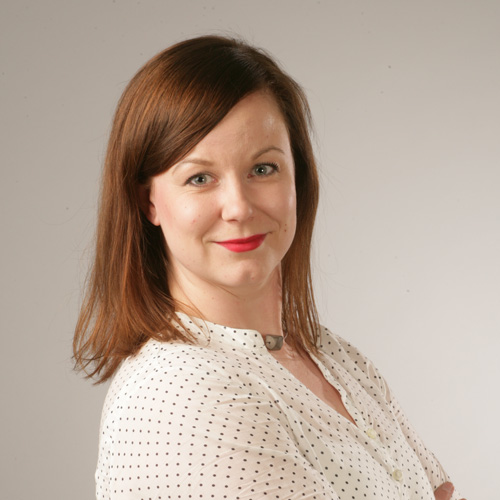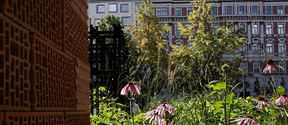Kudos – a library for material relations
Architecture as a collaboration between humans, clay and fungi.

Amid grey floors, mismatched lockers and bright artificial lights, a wooden structure rises. Its shelves, filled with fungi and clay elements of different shapes, sizes and textures, bring life to its otherwise bleak surroundings.

The work, called Kudos, is on display in Aalto University’s Väre building until 10th of October. It explores our relationship with construction, Nature, and our personal values. While it may leave visitors with more questions than answers, it nevertheless invites them to experience, sense, feel, and reflect.
‘We Western city dwellers spend about 90% of our time indoors, but often pay little attention to the materials that surround us. We were interested in how we could bring coexistence with the rest of Nature, and mutual care, indoors,’ says architect and doctoral student Elina Koivisto.
A few years ago, architects Maiju Suomi and Elina Koivisto created the Alusta Pavilion, a kind of human-friendly giant insect hotel in the heart of Helsinki. Kudos builds on the work and lessons learned from Alusta.
Both Alusta and Kudos stem from a frustration with the slow, clumsy pace of change in construction. For Koivisto and Suomi, environmental concerns are crucial, and their works raise important questions about our values—both as individuals and as a society.

‘Construction has played a huge role in creating environmental problems, but it also has enormous potential to solve them,’ Koivisto points out.
‘The idea behind both Alusta and Kudos is that there are other values and perspectives on the world, on life and on humanity. For a real transformation in construction to be possible, and for people to be truly involved, change must happen at the level of attitudes, values, and emotions. We’ve had enough information about the environmental impact of modern construction for decades, yet for some reason, change still hasn’t happened,’ Koivisto continues.
The concept of a material cycle is present in both projects, says Maiju Suomi: from death, new life emerges. For example, many fungi familiar to humans are decomposers—they turn organic waste, such as decaying plants, into nutrient-rich soil, thereby providing food for other species. In contrast, the way humans use materials is both rudimentary and wasteful. Even our recycling processes are still in their infancy, Suomi explains.

‘We really should learn from fungi and other species—how they collaborate,’ Suomi suggests.
‘It also shows us that being human-centred is totally nonsensical. If we collaborated with other species and natural processes, there would be so much to gain—both practically and joyfully. But if we insist on doing things in isolation, we end up wasting a huge amount of energy on something another species may have already figured out,’ Suomi says.

Kudos is part of Elina Koivisto’s practice-oriented doctoral research. It has evolved over several months as the fungi and mycelia have spread and grown into the desired shapes, using platforms like sawdust collected from Aalto University’s wood workshops or common reed gathered from the Otaniemi campus shores—simultaneously helping to reduce eutrophication in the area.
The various fungal elements have been developed not only in university courses led by Koivisto but also in collaboration with children during summer courses. Some of the clay elements were created in open workshops using recycled green clay from the Alusta pavilion.
‘The name of the pavilion, Kudos (meaning tissue, texture, or weave), has a double meaning: it represents a weave of experiments and diverse forms of life, while also relating to the tissue of humans and other living beings, and our embodied relationship with the building materials we use,’ Koivisto explains.
According to Koivisto and Suomi, the clay and fungi elements highlight the idea that humanity must find a balance with Nature, as we are inherently part of it—failure to do so would lead to significant problems. Kudos seeks to blur the boundaries between buildings and living organisms, exploring the forms of mutual care that are deeply rooted in our existence, yet often go unnoticed.

At its most basic, mutual care involves the materials we choose for building. But it also extends to building communities and fostering relationships—among people, and between people and their environment.
‘It’s essential to consider what sustains our lives. For instance, architecture is part of the networks that sustain life. Just as we are part of Nature, our buildings are part of the ecosystem. They provide a literal surface for connection—for microbes, fungi, and all kinds of organisms we can't even see. At the same time, they reflect different manifestations of human culture. The idea of mutual care starts at the planetary level, though it’s often overlooked,’ Suomi explains.
Fungi have existed on Earth for hundreds of millions of years and play a crucial role in ecosystems as decomposers. For example, in Alusta, fungi were used to break down wood, providing homes and nourishment for various insects. In our bodies, they play an essential role in both our gut and immune systems. Fungi are virtually unavoidable, living everywhere—even when we can't see them: in plant roots, in our bodies, and as spores in the air we breathe.
Elina Koivisto speaks about mycophilia and mycophobia—the love or fear of fungi. She notes that, in our modern, urban mindset, fear seems to outweigh love: while we proudly gather chanterelles in the forest, we’re not ready to accept anything living in our built environments.
There is, of course, reason to be cautious, Koivisto acknowledges, as some organisms can be harmful to our health. But perhaps not everything needs to be destroyed “just in case,” as studies show that a connection with Nature and living organisms can benefit us. Furthermore, the chemicals and synthetic coatings we use are also harmful to both us and the rest of Nature.
‘We’re only now waking up to the harmful effects of nanomaterials accumulating in our organs, embryos, and other species. At the same time, we still don’t fully understand the positive effects and vital connections provided by the microbes in and around us. By wiping out all living things, we risk losing something essential—physically, mentally, and culturally,’ Koivisto says.

The text on the side of the wooden structure invites visitors to experience Kudos with all their senses: by looking, touching, smelling. However, the fungi elements do not release the familiar forest scent. This is because the dry mycelium is, in a sense, hibernating—not dead, but not fully alive. Koivisto has some reservations about this:
‘The aim of the project was to explore how we could grow and borrow something for construction that could live on afterward. It would be nice to think that the fungi here are just happily sleeping for a while. But is that really the case?’
A few mycologists interviewed by Koivisto explained that, based on current knowledge, it’s not yet known whether fungi suffer when they dry out or enter a kind of drowsy, unconscious state. Scientists have discovered that fungi communicate using electrical impulses passing through the mycelia, but the purpose of these impulses is still unclear.
As Koivisto reminds us, building architecture with living organisms raises ethical questions that should be considered when using any material, as life exists everywhere and in everything.

The Alusta pavilion, located previously in the courtyard of the Museum of Architecture in Helsinki, is being relocated. Starting in spring 2025, it will serve both its buzzing residents and two-legged visitors on the Otaniemi campus. Koivisto also has plans for Kudos after its display in the Väre building ends.
‘Kudos is designed to be rebuilt in new places, in different settings. This library can always be reshaped according to its new locations—as a collaboration between human and non-human associations. Hopefully, it will be erected in many new places in various formats. Ultimately, we plan to create another project where these fungi panels can continue growing somewhere in Nature—becoming part of the circle of life,’ Koivisto concludes.
The Kudos Pavilion is a satellite exhibition of Aalto University's Designs for a Cooler Planet festival and can be experienced on the ground floor of the Väre building at Otaniementie 14 until October 10. After that, the life of the pavilion will continue elsewhere, either for people or for Nature to experience.


Architecture as a collaboration between humans, clay and fungi.

Visit Designs for a Cooler Planet festival in Otaniemi on 6 Sep – 3 Oct 2024 to challenge your perception of the possible.

Alusta, built from clay and populated by plants, is a sanctuary for pollinators and a meeting place for all living things



